Financial and Economic Literacy for Managers Solution Assignment
VerifiedAdded on 2021/01/02
|12
|3396
|237
AI Summary
Contribute Materials
Your contribution can guide someone’s learning journey. Share your
documents today.
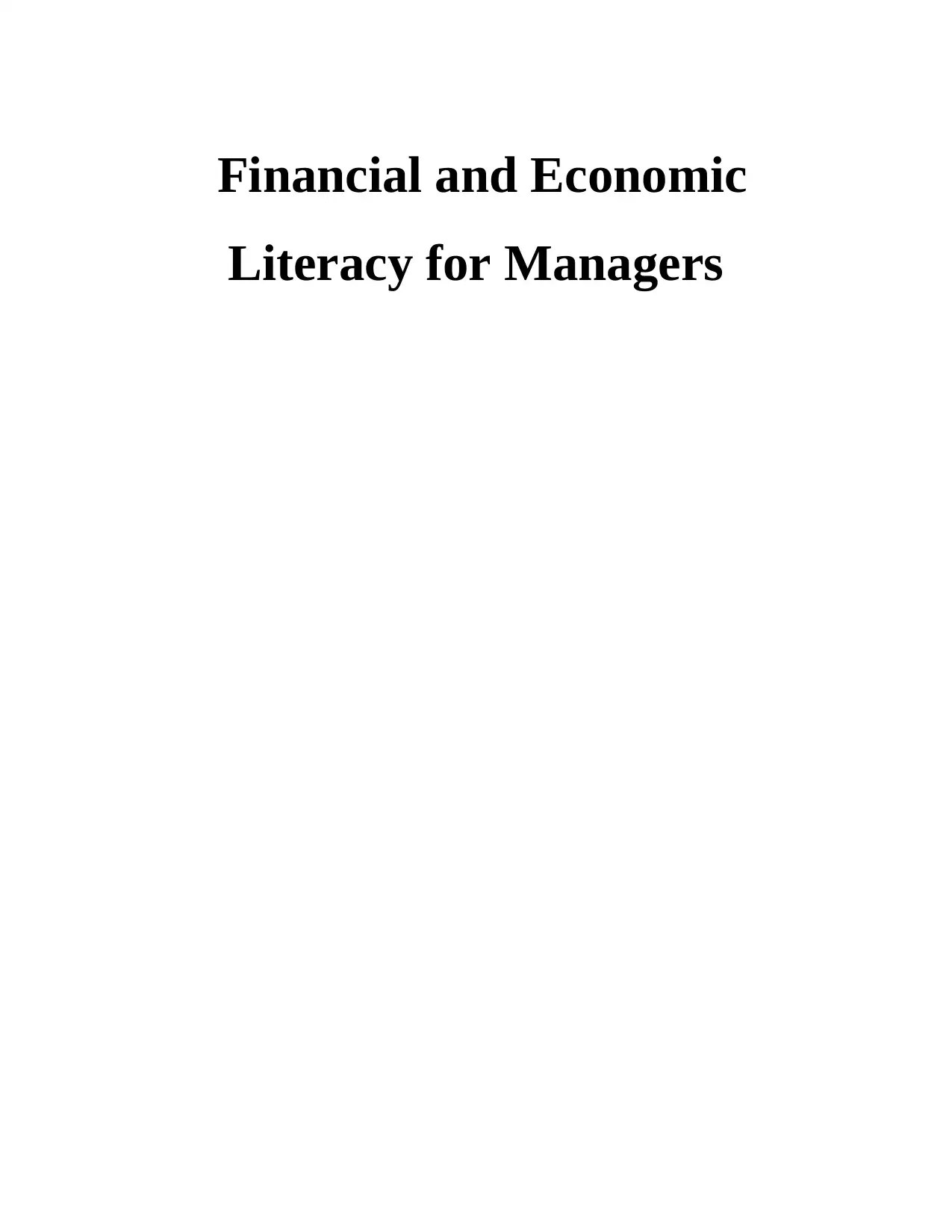
Financial and Economic
Literacy for Managers
Literacy for Managers
Secure Best Marks with AI Grader
Need help grading? Try our AI Grader for instant feedback on your assignments.
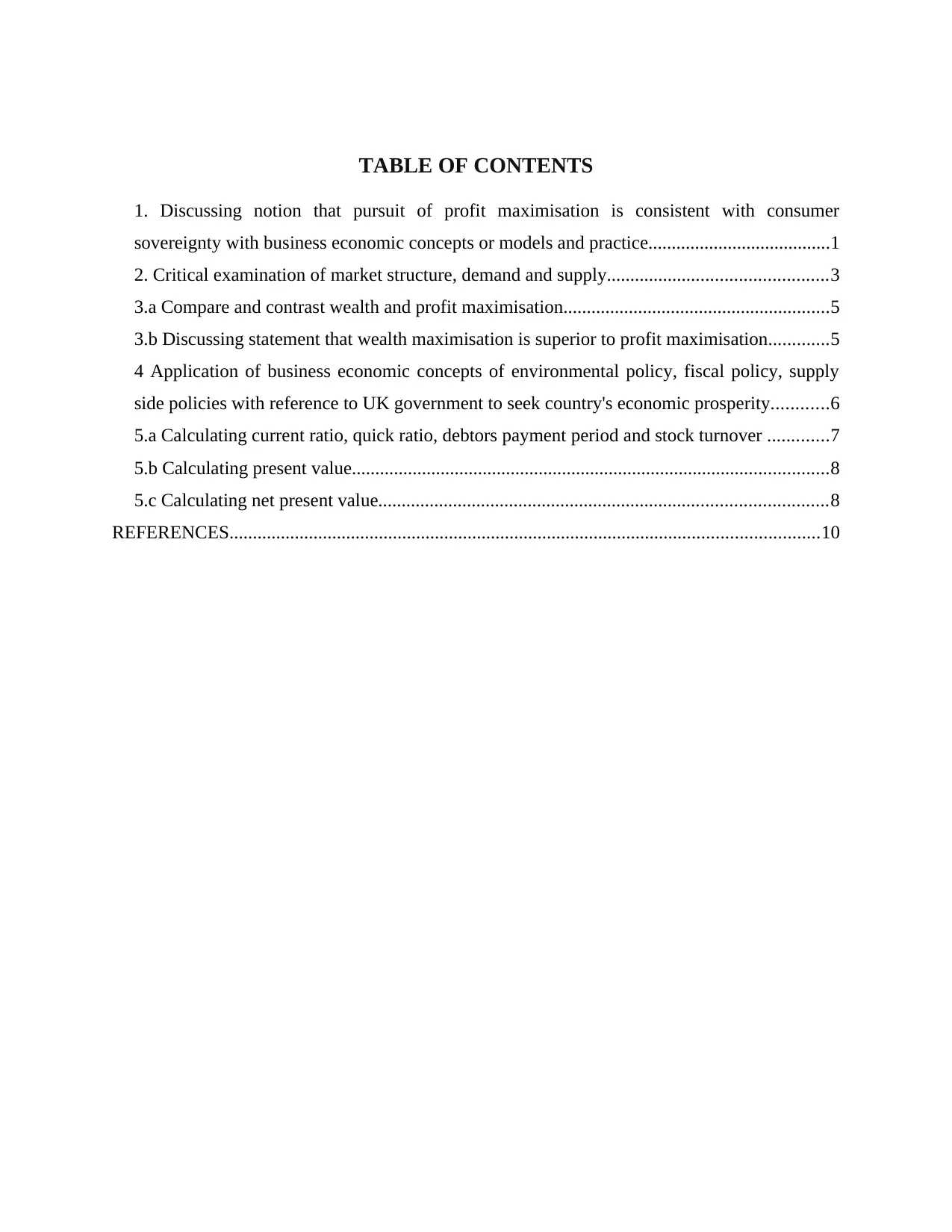
TABLE OF CONTENTS
1. Discussing notion that pursuit of profit maximisation is consistent with consumer
sovereignty with business economic concepts or models and practice.......................................1
2. Critical examination of market structure, demand and supply...............................................3
3.a Compare and contrast wealth and profit maximisation.........................................................5
3.b Discussing statement that wealth maximisation is superior to profit maximisation.............5
4 Application of business economic concepts of environmental policy, fiscal policy, supply
side policies with reference to UK government to seek country's economic prosperity............6
5.a Calculating current ratio, quick ratio, debtors payment period and stock turnover .............7
5.b Calculating present value......................................................................................................8
5.c Calculating net present value................................................................................................8
REFERENCES..............................................................................................................................10
1. Discussing notion that pursuit of profit maximisation is consistent with consumer
sovereignty with business economic concepts or models and practice.......................................1
2. Critical examination of market structure, demand and supply...............................................3
3.a Compare and contrast wealth and profit maximisation.........................................................5
3.b Discussing statement that wealth maximisation is superior to profit maximisation.............5
4 Application of business economic concepts of environmental policy, fiscal policy, supply
side policies with reference to UK government to seek country's economic prosperity............6
5.a Calculating current ratio, quick ratio, debtors payment period and stock turnover .............7
5.b Calculating present value......................................................................................................8
5.c Calculating net present value................................................................................................8
REFERENCES..............................................................................................................................10
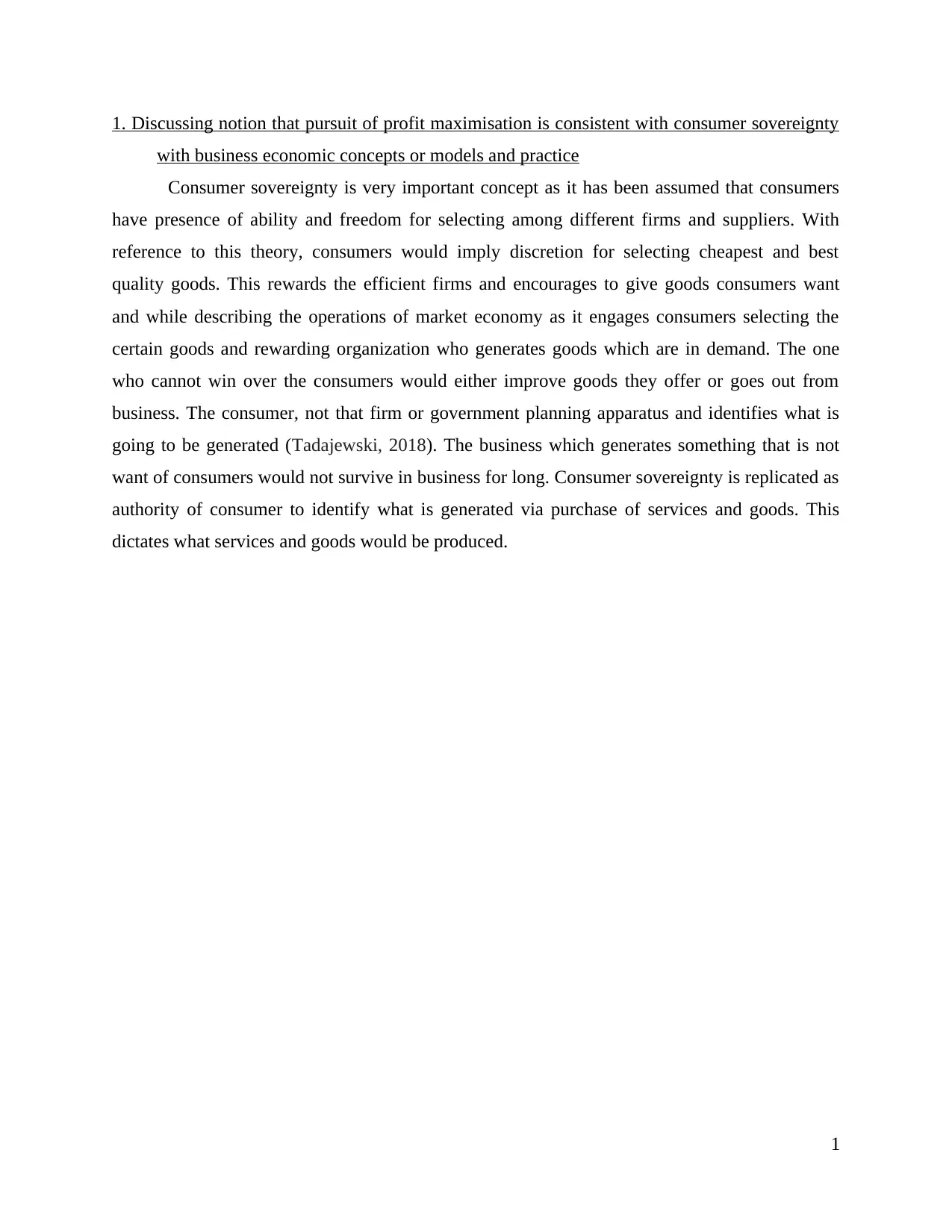
1. Discussing notion that pursuit of profit maximisation is consistent with consumer sovereignty
with business economic concepts or models and practice
Consumer sovereignty is very important concept as it has been assumed that consumers
have presence of ability and freedom for selecting among different firms and suppliers. With
reference to this theory, consumers would imply discretion for selecting cheapest and best
quality goods. This rewards the efficient firms and encourages to give goods consumers want
and while describing the operations of market economy as it engages consumers selecting the
certain goods and rewarding organization who generates goods which are in demand. The one
who cannot win over the consumers would either improve goods they offer or goes out from
business. The consumer, not that firm or government planning apparatus and identifies what is
going to be generated (Tadajewski, 2018). The business which generates something that is not
want of consumers would not survive in business for long. Consumer sovereignty is replicated as
authority of consumer to identify what is generated via purchase of services and goods. This
dictates what services and goods would be produced.
1
with business economic concepts or models and practice
Consumer sovereignty is very important concept as it has been assumed that consumers
have presence of ability and freedom for selecting among different firms and suppliers. With
reference to this theory, consumers would imply discretion for selecting cheapest and best
quality goods. This rewards the efficient firms and encourages to give goods consumers want
and while describing the operations of market economy as it engages consumers selecting the
certain goods and rewarding organization who generates goods which are in demand. The one
who cannot win over the consumers would either improve goods they offer or goes out from
business. The consumer, not that firm or government planning apparatus and identifies what is
going to be generated (Tadajewski, 2018). The business which generates something that is not
want of consumers would not survive in business for long. Consumer sovereignty is replicated as
authority of consumer to identify what is generated via purchase of services and goods. This
dictates what services and goods would be produced.
1
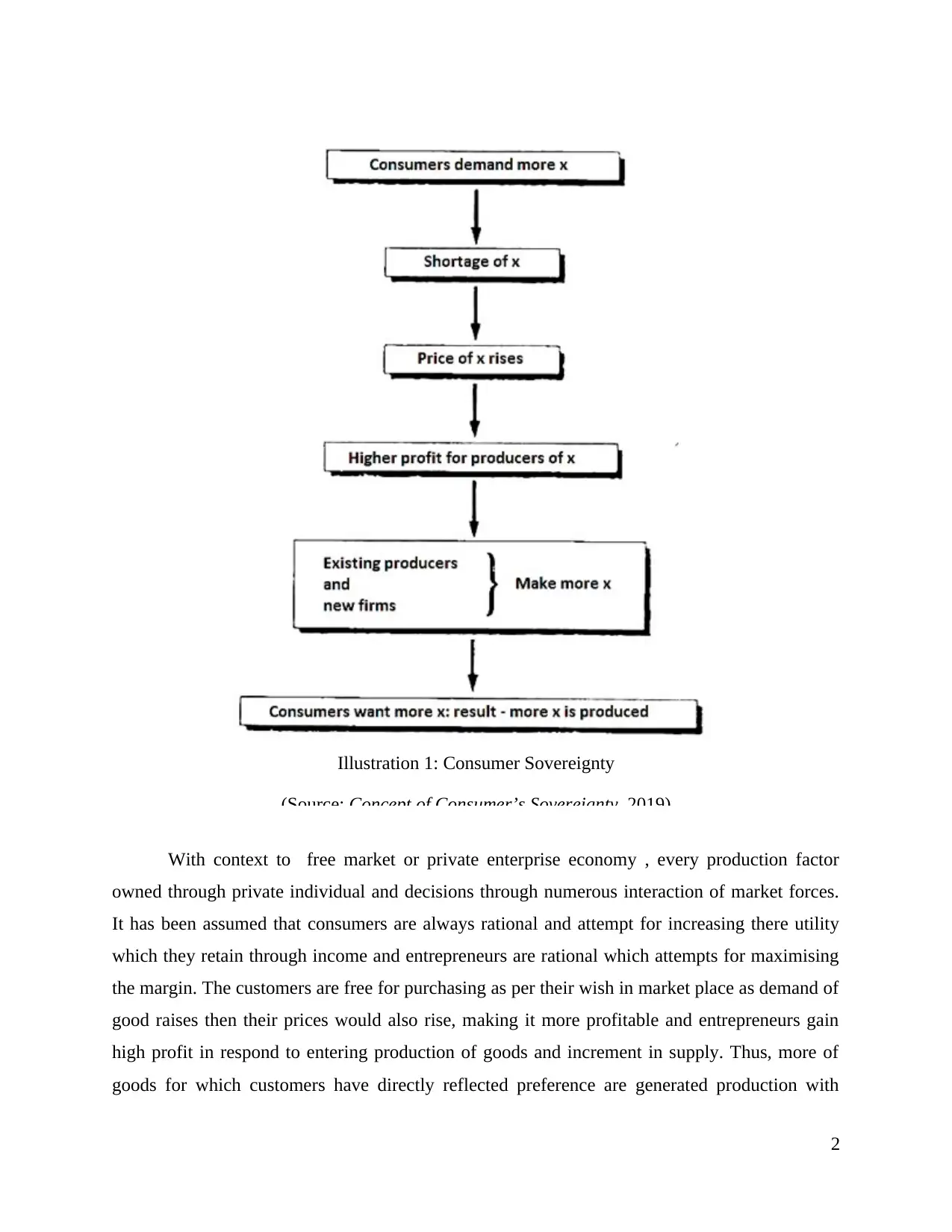
Illustration 1: Consumer Sovereignty
(Source: Concept of Consumer’s Sovereignty, 2019)
With context to free market or private enterprise economy , every production factor
owned through private individual and decisions through numerous interaction of market forces.
It has been assumed that consumers are always rational and attempt for increasing there utility
which they retain through income and entrepreneurs are rational which attempts for maximising
the margin. The customers are free for purchasing as per their wish in market place as demand of
good raises then their prices would also rise, making it more profitable and entrepreneurs gain
high profit in respond to entering production of goods and increment in supply. Thus, more of
goods for which customers have directly reflected preference are generated production with
2
(Source: Concept of Consumer’s Sovereignty, 2019)
With context to free market or private enterprise economy , every production factor
owned through private individual and decisions through numerous interaction of market forces.
It has been assumed that consumers are always rational and attempt for increasing there utility
which they retain through income and entrepreneurs are rational which attempts for maximising
the margin. The customers are free for purchasing as per their wish in market place as demand of
good raises then their prices would also rise, making it more profitable and entrepreneurs gain
high profit in respond to entering production of goods and increment in supply. Thus, more of
goods for which customers have directly reflected preference are generated production with
2
Secure Best Marks with AI Grader
Need help grading? Try our AI Grader for instant feedback on your assignments.
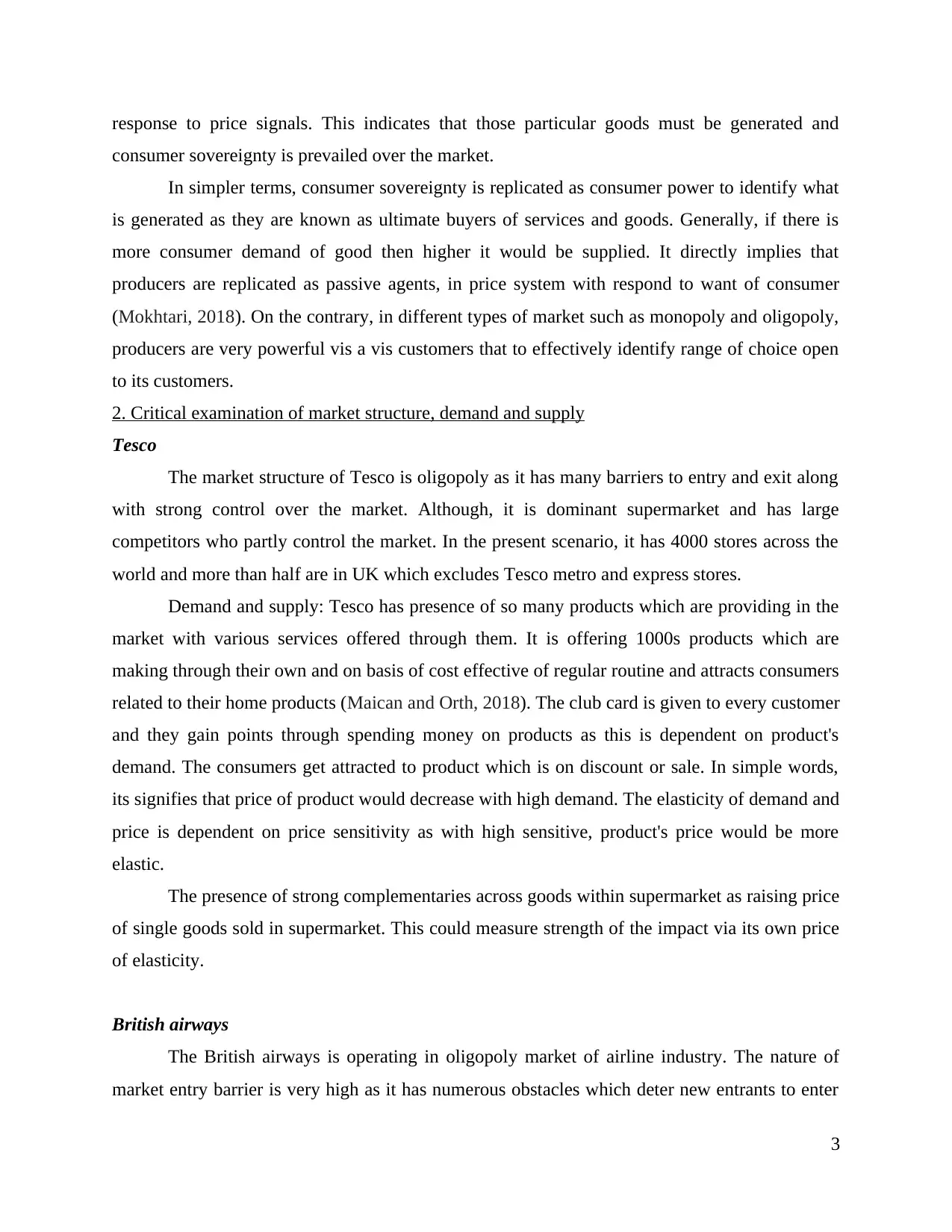
response to price signals. This indicates that those particular goods must be generated and
consumer sovereignty is prevailed over the market.
In simpler terms, consumer sovereignty is replicated as consumer power to identify what
is generated as they are known as ultimate buyers of services and goods. Generally, if there is
more consumer demand of good then higher it would be supplied. It directly implies that
producers are replicated as passive agents, in price system with respond to want of consumer
(Mokhtari, 2018). On the contrary, in different types of market such as monopoly and oligopoly,
producers are very powerful vis a vis customers that to effectively identify range of choice open
to its customers.
2. Critical examination of market structure, demand and supply
Tesco
The market structure of Tesco is oligopoly as it has many barriers to entry and exit along
with strong control over the market. Although, it is dominant supermarket and has large
competitors who partly control the market. In the present scenario, it has 4000 stores across the
world and more than half are in UK which excludes Tesco metro and express stores.
Demand and supply: Tesco has presence of so many products which are providing in the
market with various services offered through them. It is offering 1000s products which are
making through their own and on basis of cost effective of regular routine and attracts consumers
related to their home products (Maican and Orth, 2018). The club card is given to every customer
and they gain points through spending money on products as this is dependent on product's
demand. The consumers get attracted to product which is on discount or sale. In simple words,
its signifies that price of product would decrease with high demand. The elasticity of demand and
price is dependent on price sensitivity as with high sensitive, product's price would be more
elastic.
The presence of strong complementaries across goods within supermarket as raising price
of single goods sold in supermarket. This could measure strength of the impact via its own price
of elasticity.
British airways
The British airways is operating in oligopoly market of airline industry. The nature of
market entry barrier is very high as it has numerous obstacles which deter new entrants to enter
3
consumer sovereignty is prevailed over the market.
In simpler terms, consumer sovereignty is replicated as consumer power to identify what
is generated as they are known as ultimate buyers of services and goods. Generally, if there is
more consumer demand of good then higher it would be supplied. It directly implies that
producers are replicated as passive agents, in price system with respond to want of consumer
(Mokhtari, 2018). On the contrary, in different types of market such as monopoly and oligopoly,
producers are very powerful vis a vis customers that to effectively identify range of choice open
to its customers.
2. Critical examination of market structure, demand and supply
Tesco
The market structure of Tesco is oligopoly as it has many barriers to entry and exit along
with strong control over the market. Although, it is dominant supermarket and has large
competitors who partly control the market. In the present scenario, it has 4000 stores across the
world and more than half are in UK which excludes Tesco metro and express stores.
Demand and supply: Tesco has presence of so many products which are providing in the
market with various services offered through them. It is offering 1000s products which are
making through their own and on basis of cost effective of regular routine and attracts consumers
related to their home products (Maican and Orth, 2018). The club card is given to every customer
and they gain points through spending money on products as this is dependent on product's
demand. The consumers get attracted to product which is on discount or sale. In simple words,
its signifies that price of product would decrease with high demand. The elasticity of demand and
price is dependent on price sensitivity as with high sensitive, product's price would be more
elastic.
The presence of strong complementaries across goods within supermarket as raising price
of single goods sold in supermarket. This could measure strength of the impact via its own price
of elasticity.
British airways
The British airways is operating in oligopoly market of airline industry. The nature of
market entry barrier is very high as it has numerous obstacles which deter new entrants to enter
3
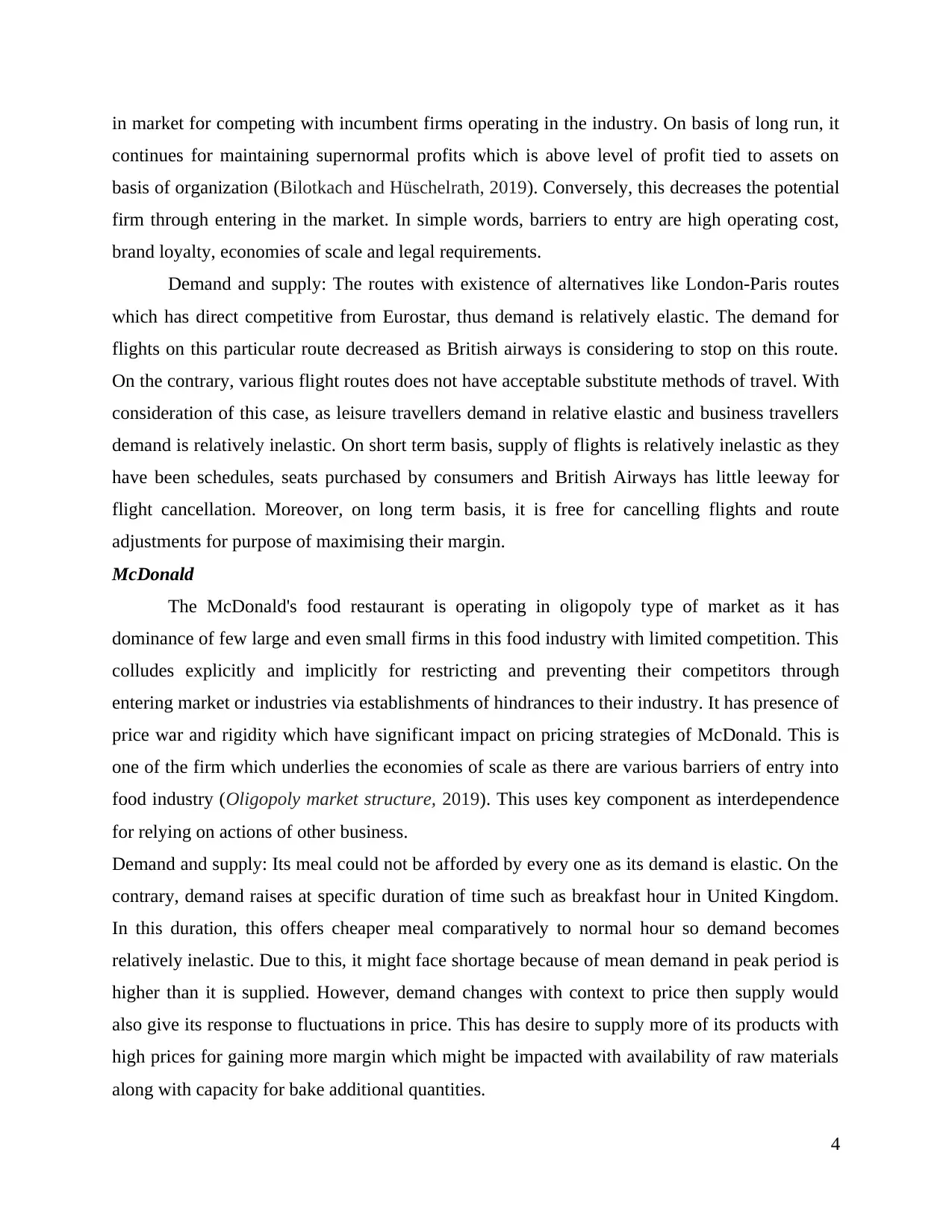
in market for competing with incumbent firms operating in the industry. On basis of long run, it
continues for maintaining supernormal profits which is above level of profit tied to assets on
basis of organization (Bilotkach and Hüschelrath, 2019). Conversely, this decreases the potential
firm through entering in the market. In simple words, barriers to entry are high operating cost,
brand loyalty, economies of scale and legal requirements.
Demand and supply: The routes with existence of alternatives like London-Paris routes
which has direct competitive from Eurostar, thus demand is relatively elastic. The demand for
flights on this particular route decreased as British airways is considering to stop on this route.
On the contrary, various flight routes does not have acceptable substitute methods of travel. With
consideration of this case, as leisure travellers demand in relative elastic and business travellers
demand is relatively inelastic. On short term basis, supply of flights is relatively inelastic as they
have been schedules, seats purchased by consumers and British Airways has little leeway for
flight cancellation. Moreover, on long term basis, it is free for cancelling flights and route
adjustments for purpose of maximising their margin.
McDonald
The McDonald's food restaurant is operating in oligopoly type of market as it has
dominance of few large and even small firms in this food industry with limited competition. This
colludes explicitly and implicitly for restricting and preventing their competitors through
entering market or industries via establishments of hindrances to their industry. It has presence of
price war and rigidity which have significant impact on pricing strategies of McDonald. This is
one of the firm which underlies the economies of scale as there are various barriers of entry into
food industry (Oligopoly market structure, 2019). This uses key component as interdependence
for relying on actions of other business.
Demand and supply: Its meal could not be afforded by every one as its demand is elastic. On the
contrary, demand raises at specific duration of time such as breakfast hour in United Kingdom.
In this duration, this offers cheaper meal comparatively to normal hour so demand becomes
relatively inelastic. Due to this, it might face shortage because of mean demand in peak period is
higher than it is supplied. However, demand changes with context to price then supply would
also give its response to fluctuations in price. This has desire to supply more of its products with
high prices for gaining more margin which might be impacted with availability of raw materials
along with capacity for bake additional quantities.
4
continues for maintaining supernormal profits which is above level of profit tied to assets on
basis of organization (Bilotkach and Hüschelrath, 2019). Conversely, this decreases the potential
firm through entering in the market. In simple words, barriers to entry are high operating cost,
brand loyalty, economies of scale and legal requirements.
Demand and supply: The routes with existence of alternatives like London-Paris routes
which has direct competitive from Eurostar, thus demand is relatively elastic. The demand for
flights on this particular route decreased as British airways is considering to stop on this route.
On the contrary, various flight routes does not have acceptable substitute methods of travel. With
consideration of this case, as leisure travellers demand in relative elastic and business travellers
demand is relatively inelastic. On short term basis, supply of flights is relatively inelastic as they
have been schedules, seats purchased by consumers and British Airways has little leeway for
flight cancellation. Moreover, on long term basis, it is free for cancelling flights and route
adjustments for purpose of maximising their margin.
McDonald
The McDonald's food restaurant is operating in oligopoly type of market as it has
dominance of few large and even small firms in this food industry with limited competition. This
colludes explicitly and implicitly for restricting and preventing their competitors through
entering market or industries via establishments of hindrances to their industry. It has presence of
price war and rigidity which have significant impact on pricing strategies of McDonald. This is
one of the firm which underlies the economies of scale as there are various barriers of entry into
food industry (Oligopoly market structure, 2019). This uses key component as interdependence
for relying on actions of other business.
Demand and supply: Its meal could not be afforded by every one as its demand is elastic. On the
contrary, demand raises at specific duration of time such as breakfast hour in United Kingdom.
In this duration, this offers cheaper meal comparatively to normal hour so demand becomes
relatively inelastic. Due to this, it might face shortage because of mean demand in peak period is
higher than it is supplied. However, demand changes with context to price then supply would
also give its response to fluctuations in price. This has desire to supply more of its products with
high prices for gaining more margin which might be impacted with availability of raw materials
along with capacity for bake additional quantities.
4

Hairdressers
The market structure for hairdressers is monopolistic as it has low barriers for entries,
various firms and even product differentiation as well (Ren, Hu and Cui, 2019). This lays
emphasis on style and elegance and caters glamorous and sophistication for night outs with
different special packages and choices.
Demand and supply: The customers increase then this gives impact on price which falls as it is
downward sloping and in this monopoly market, it supply in whole market supply.
3.a Compare and contrast wealth and profit maximisation
Wealth maximisation is universally accepted and proper objective of a business, The
managers undertake decisions which maximize the net present value of shareholders along with
their wealth. It implies that fundamental goal for maximising shares market value. However,
profit maximisation is traditional approach as undergoes to identify the best output and level of
prices in order for increasing its return. The organization would usually adjust multiple
influential factors like sale price, production cost along with level of output as mode to reach its
goal of profit. The overall aim of business enterprises to get at least satisfactory return on
invested funds to sustain in market for long duration.
Profit maximisation is on basis of increment in profits and sales and wealth maximisation
is on basis of cash flows. Profit maximisation lays focus on short term objectives and wealth
maximisation focuses on long term (Ciccarelli, De Fraja. and Tiezzi, 2018). In the similar aspect,
risk and uncertainty is ignored in profit maximisation whereas it is considered in wealth
maximisation. On basis of reliability, in new business environment profit maximisation is
difficult, unrealistic, immoral and inappropriate. The aim of wealth maximisation ensures fair
return to shareholders, promotes financial discipline in management and reserves fund for
growth and expansion.
3.b Discussing statement that wealth maximisation is superior to profit maximisation
In the present scenario, wealth maximisation is superior to profit maximisation as it
overcome the limitations. This maximises the net wealth of shareholders of company. It is only
possible when policies of organization are pursued which would raise market value of company's
shares. It is superior in mode which is on basis of cash flow but does not account margin. It is
superior because this duration of expected returns. This distant flows are directly uncertain,
covers into comparable values at base duration and it facilitates better comparison of financial
5
The market structure for hairdressers is monopolistic as it has low barriers for entries,
various firms and even product differentiation as well (Ren, Hu and Cui, 2019). This lays
emphasis on style and elegance and caters glamorous and sophistication for night outs with
different special packages and choices.
Demand and supply: The customers increase then this gives impact on price which falls as it is
downward sloping and in this monopoly market, it supply in whole market supply.
3.a Compare and contrast wealth and profit maximisation
Wealth maximisation is universally accepted and proper objective of a business, The
managers undertake decisions which maximize the net present value of shareholders along with
their wealth. It implies that fundamental goal for maximising shares market value. However,
profit maximisation is traditional approach as undergoes to identify the best output and level of
prices in order for increasing its return. The organization would usually adjust multiple
influential factors like sale price, production cost along with level of output as mode to reach its
goal of profit. The overall aim of business enterprises to get at least satisfactory return on
invested funds to sustain in market for long duration.
Profit maximisation is on basis of increment in profits and sales and wealth maximisation
is on basis of cash flows. Profit maximisation lays focus on short term objectives and wealth
maximisation focuses on long term (Ciccarelli, De Fraja. and Tiezzi, 2018). In the similar aspect,
risk and uncertainty is ignored in profit maximisation whereas it is considered in wealth
maximisation. On basis of reliability, in new business environment profit maximisation is
difficult, unrealistic, immoral and inappropriate. The aim of wealth maximisation ensures fair
return to shareholders, promotes financial discipline in management and reserves fund for
growth and expansion.
3.b Discussing statement that wealth maximisation is superior to profit maximisation
In the present scenario, wealth maximisation is superior to profit maximisation as it
overcome the limitations. This maximises the net wealth of shareholders of company. It is only
possible when policies of organization are pursued which would raise market value of company's
shares. It is superior in mode which is on basis of cash flow but does not account margin. It is
superior because this duration of expected returns. This distant flows are directly uncertain,
covers into comparable values at base duration and it facilitates better comparison of financial
5
Paraphrase This Document
Need a fresh take? Get an instant paraphrase of this document with our AI Paraphraser
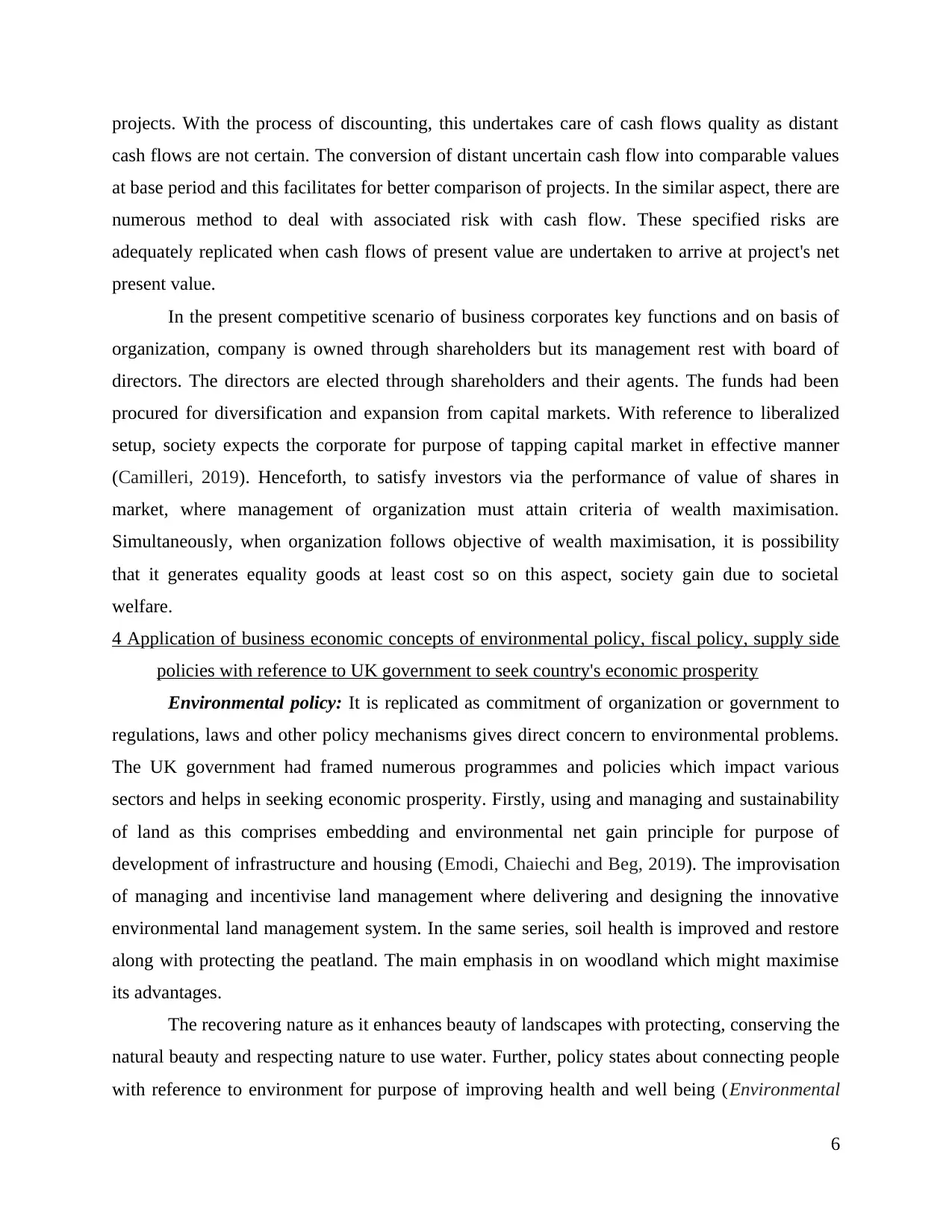
projects. With the process of discounting, this undertakes care of cash flows quality as distant
cash flows are not certain. The conversion of distant uncertain cash flow into comparable values
at base period and this facilitates for better comparison of projects. In the similar aspect, there are
numerous method to deal with associated risk with cash flow. These specified risks are
adequately replicated when cash flows of present value are undertaken to arrive at project's net
present value.
In the present competitive scenario of business corporates key functions and on basis of
organization, company is owned through shareholders but its management rest with board of
directors. The directors are elected through shareholders and their agents. The funds had been
procured for diversification and expansion from capital markets. With reference to liberalized
setup, society expects the corporate for purpose of tapping capital market in effective manner
(Camilleri, 2019). Henceforth, to satisfy investors via the performance of value of shares in
market, where management of organization must attain criteria of wealth maximisation.
Simultaneously, when organization follows objective of wealth maximisation, it is possibility
that it generates equality goods at least cost so on this aspect, society gain due to societal
welfare.
4 Application of business economic concepts of environmental policy, fiscal policy, supply side
policies with reference to UK government to seek country's economic prosperity
Environmental policy: It is replicated as commitment of organization or government to
regulations, laws and other policy mechanisms gives direct concern to environmental problems.
The UK government had framed numerous programmes and policies which impact various
sectors and helps in seeking economic prosperity. Firstly, using and managing and sustainability
of land as this comprises embedding and environmental net gain principle for purpose of
development of infrastructure and housing (Emodi, Chaiechi and Beg, 2019). The improvisation
of managing and incentivise land management where delivering and designing the innovative
environmental land management system. In the same series, soil health is improved and restore
along with protecting the peatland. The main emphasis in on woodland which might maximise
its advantages.
The recovering nature as it enhances beauty of landscapes with protecting, conserving the
natural beauty and respecting nature to use water. Further, policy states about connecting people
with reference to environment for purpose of improving health and well being (Environmental
6
cash flows are not certain. The conversion of distant uncertain cash flow into comparable values
at base period and this facilitates for better comparison of projects. In the similar aspect, there are
numerous method to deal with associated risk with cash flow. These specified risks are
adequately replicated when cash flows of present value are undertaken to arrive at project's net
present value.
In the present competitive scenario of business corporates key functions and on basis of
organization, company is owned through shareholders but its management rest with board of
directors. The directors are elected through shareholders and their agents. The funds had been
procured for diversification and expansion from capital markets. With reference to liberalized
setup, society expects the corporate for purpose of tapping capital market in effective manner
(Camilleri, 2019). Henceforth, to satisfy investors via the performance of value of shares in
market, where management of organization must attain criteria of wealth maximisation.
Simultaneously, when organization follows objective of wealth maximisation, it is possibility
that it generates equality goods at least cost so on this aspect, society gain due to societal
welfare.
4 Application of business economic concepts of environmental policy, fiscal policy, supply side
policies with reference to UK government to seek country's economic prosperity
Environmental policy: It is replicated as commitment of organization or government to
regulations, laws and other policy mechanisms gives direct concern to environmental problems.
The UK government had framed numerous programmes and policies which impact various
sectors and helps in seeking economic prosperity. Firstly, using and managing and sustainability
of land as this comprises embedding and environmental net gain principle for purpose of
development of infrastructure and housing (Emodi, Chaiechi and Beg, 2019). The improvisation
of managing and incentivise land management where delivering and designing the innovative
environmental land management system. In the same series, soil health is improved and restore
along with protecting the peatland. The main emphasis in on woodland which might maximise
its advantages.
The recovering nature as it enhances beauty of landscapes with protecting, conserving the
natural beauty and respecting nature to use water. Further, policy states about connecting people
with reference to environment for purpose of improving health and well being (Environmental
6

policy, 2019). The most vital is raising resource efficiency and decreases the environmental
impacts at end of life by minimising pollution.
Fiscal policy: It is referred as decision of government related to taxing and spending as in
case government has desire for stimulating economic growth, this would raise spending for its
goods and services. This would raise demand for services and goods as demand grows,
production must go up so in this context company might require for hiring more people. The
main aspect of fiscal policy is related to tax which leads to economic prosperity as alteration in
taxation level and government spending gives influence on rate of economic growth. The
expansionary fiscal policy is used for purpose of stimulating the aggregate demand and boosts
rate of economic growth (Kin, 2018). It engages high spending, lower taxes and would outcome
in higher government borrowing. This policy would be used in recession or period with negative
output gap.
In the same series, deflationary policy of UK is used for decreasing aggregate demand
and decreases inflationary pressures. This engages lower spending of government along with
higher taxes. This would decrease in fall in borrowing of government. The government could
pursue its objective of fiscal policy in very aggressive manner by adjusting both spending and
taxes (UK Fiscal policy, 2019). Henceforth, in overhead economy, taxes could be raised by
government and decrease spending with desire of dampening growth.
Supply side policy: It includes policies which raises ability of economy's productive
potential as there are numerous actions that government undertake for improving performance of
supply side. The recent supply side policies of UK government for attaining economic prosperity
is such as relaxation of trading laws of Sunday but worries related to work life balance. The
objective for undertaking advantage of external economies of scale through attracting the inward
investment with 24 new regional enterprises zones (Supply side policies, 2018). The tax relied
for businesses directly investing in low carbon technologies designed for purpose of raising
investment in renewable energy. Furthermore, UK National infrastructure plan with multiple
ranges of projects such as new nuclear power station in Somerset at Hinkley point.
5.a Calculating current ratio, quick ratio, debtors payment period and stock turnover
Particulars Formula 2017 2018
Current assets 3277 2460
Current liabilities 2833 2097
7
impacts at end of life by minimising pollution.
Fiscal policy: It is referred as decision of government related to taxing and spending as in
case government has desire for stimulating economic growth, this would raise spending for its
goods and services. This would raise demand for services and goods as demand grows,
production must go up so in this context company might require for hiring more people. The
main aspect of fiscal policy is related to tax which leads to economic prosperity as alteration in
taxation level and government spending gives influence on rate of economic growth. The
expansionary fiscal policy is used for purpose of stimulating the aggregate demand and boosts
rate of economic growth (Kin, 2018). It engages high spending, lower taxes and would outcome
in higher government borrowing. This policy would be used in recession or period with negative
output gap.
In the same series, deflationary policy of UK is used for decreasing aggregate demand
and decreases inflationary pressures. This engages lower spending of government along with
higher taxes. This would decrease in fall in borrowing of government. The government could
pursue its objective of fiscal policy in very aggressive manner by adjusting both spending and
taxes (UK Fiscal policy, 2019). Henceforth, in overhead economy, taxes could be raised by
government and decrease spending with desire of dampening growth.
Supply side policy: It includes policies which raises ability of economy's productive
potential as there are numerous actions that government undertake for improving performance of
supply side. The recent supply side policies of UK government for attaining economic prosperity
is such as relaxation of trading laws of Sunday but worries related to work life balance. The
objective for undertaking advantage of external economies of scale through attracting the inward
investment with 24 new regional enterprises zones (Supply side policies, 2018). The tax relied
for businesses directly investing in low carbon technologies designed for purpose of raising
investment in renewable energy. Furthermore, UK National infrastructure plan with multiple
ranges of projects such as new nuclear power station in Somerset at Hinkley point.
5.a Calculating current ratio, quick ratio, debtors payment period and stock turnover
Particulars Formula 2017 2018
Current assets 3277 2460
Current liabilities 2833 2097
7
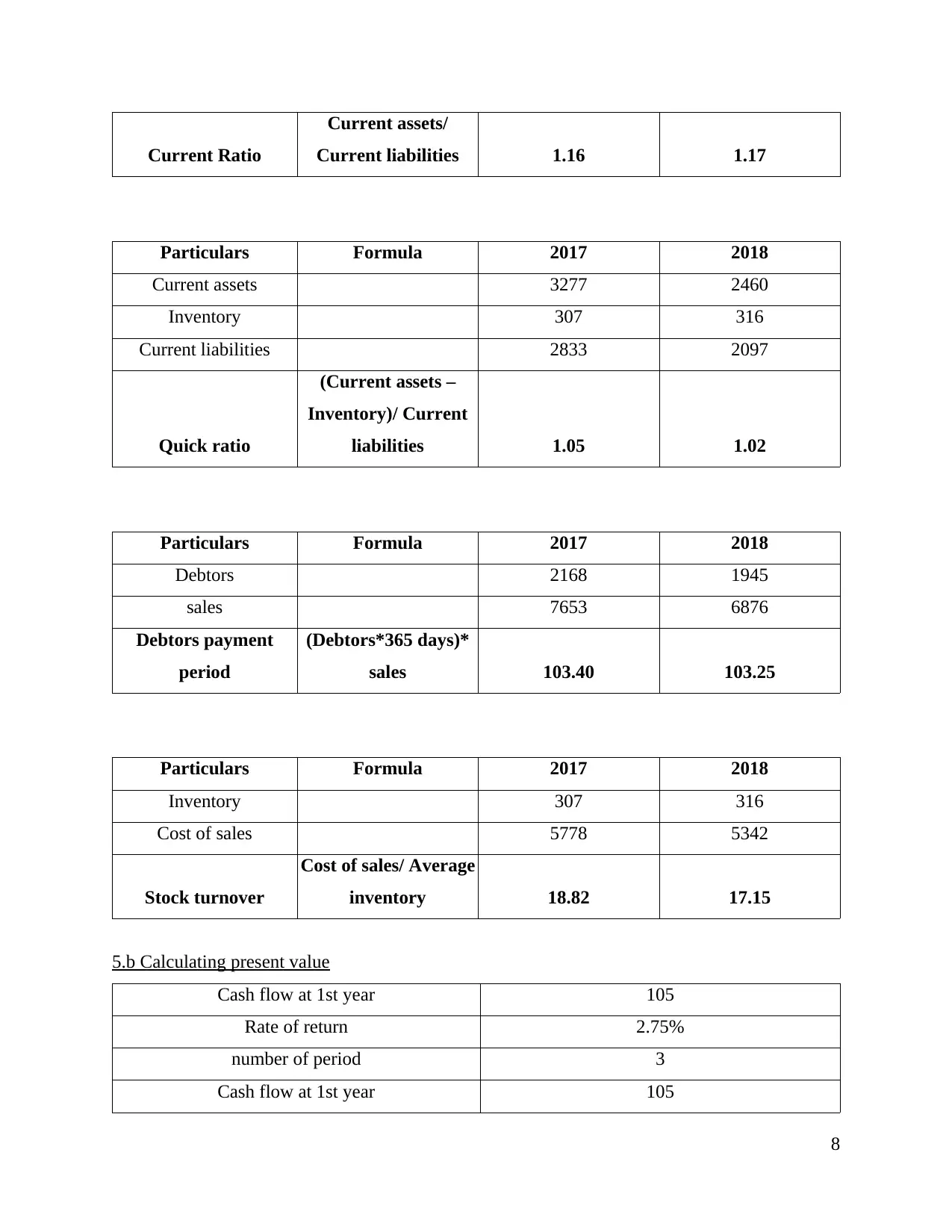
Current Ratio
Current assets/
Current liabilities 1.16 1.17
Particulars Formula 2017 2018
Current assets 3277 2460
Inventory 307 316
Current liabilities 2833 2097
Quick ratio
(Current assets –
Inventory)/ Current
liabilities 1.05 1.02
Particulars Formula 2017 2018
Debtors 2168 1945
sales 7653 6876
Debtors payment
period
(Debtors*365 days)*
sales 103.40 103.25
Particulars Formula 2017 2018
Inventory 307 316
Cost of sales 5778 5342
Stock turnover
Cost of sales/ Average
inventory 18.82 17.15
5.b Calculating present value
Cash flow at 1st year 105
Rate of return 2.75%
number of period 3
Cash flow at 1st year 105
8
Current assets/
Current liabilities 1.16 1.17
Particulars Formula 2017 2018
Current assets 3277 2460
Inventory 307 316
Current liabilities 2833 2097
Quick ratio
(Current assets –
Inventory)/ Current
liabilities 1.05 1.02
Particulars Formula 2017 2018
Debtors 2168 1945
sales 7653 6876
Debtors payment
period
(Debtors*365 days)*
sales 103.40 103.25
Particulars Formula 2017 2018
Inventory 307 316
Cost of sales 5778 5342
Stock turnover
Cost of sales/ Average
inventory 18.82 17.15
5.b Calculating present value
Cash flow at 1st year 105
Rate of return 2.75%
number of period 3
Cash flow at 1st year 105
8
Secure Best Marks with AI Grader
Need help grading? Try our AI Grader for instant feedback on your assignments.
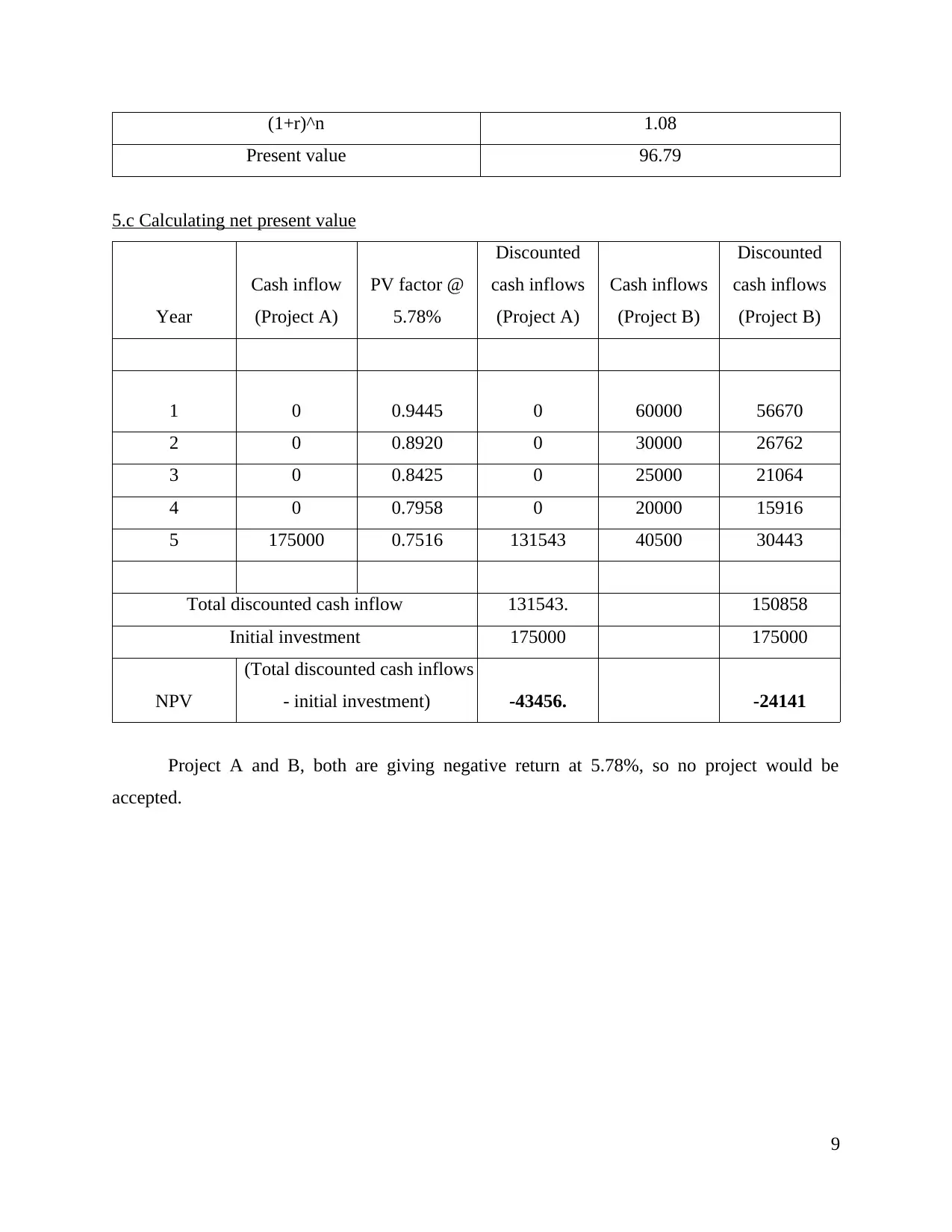
(1+r)^n 1.08
Present value 96.79
5.c Calculating net present value
Year
Cash inflow
(Project A)
PV factor @
5.78%
Discounted
cash inflows
(Project A)
Cash inflows
(Project B)
Discounted
cash inflows
(Project B)
1 0 0.9445 0 60000 56670
2 0 0.8920 0 30000 26762
3 0 0.8425 0 25000 21064
4 0 0.7958 0 20000 15916
5 175000 0.7516 131543 40500 30443
Total discounted cash inflow 131543. 150858
Initial investment 175000 175000
NPV
(Total discounted cash inflows
- initial investment) -43456. -24141
Project A and B, both are giving negative return at 5.78%, so no project would be
accepted.
9
Present value 96.79
5.c Calculating net present value
Year
Cash inflow
(Project A)
PV factor @
5.78%
Discounted
cash inflows
(Project A)
Cash inflows
(Project B)
Discounted
cash inflows
(Project B)
1 0 0.9445 0 60000 56670
2 0 0.8920 0 30000 26762
3 0 0.8425 0 25000 21064
4 0 0.7958 0 20000 15916
5 175000 0.7516 131543 40500 30443
Total discounted cash inflow 131543. 150858
Initial investment 175000 175000
NPV
(Total discounted cash inflows
- initial investment) -43456. -24141
Project A and B, both are giving negative return at 5.78%, so no project would be
accepted.
9
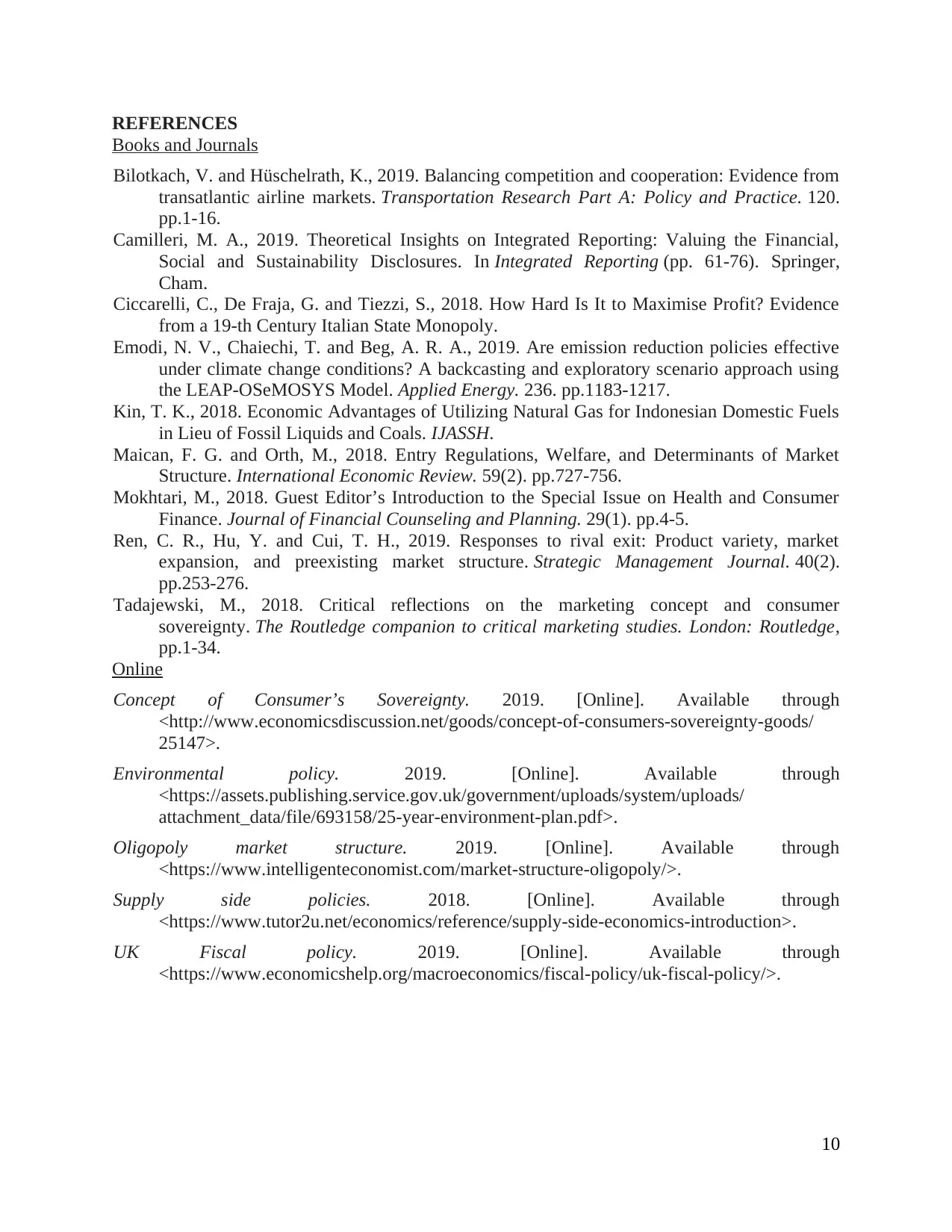
REFERENCES
Books and Journals
Bilotkach, V. and Hüschelrath, K., 2019. Balancing competition and cooperation: Evidence from
transatlantic airline markets. Transportation Research Part A: Policy and Practice. 120.
pp.1-16.
Camilleri, M. A., 2019. Theoretical Insights on Integrated Reporting: Valuing the Financial,
Social and Sustainability Disclosures. In Integrated Reporting (pp. 61-76). Springer,
Cham.
Ciccarelli, C., De Fraja, G. and Tiezzi, S., 2018. How Hard Is It to Maximise Profit? Evidence
from a 19-th Century Italian State Monopoly.
Emodi, N. V., Chaiechi, T. and Beg, A. R. A., 2019. Are emission reduction policies effective
under climate change conditions? A backcasting and exploratory scenario approach using
the LEAP-OSeMOSYS Model. Applied Energy. 236. pp.1183-1217.
Kin, T. K., 2018. Economic Advantages of Utilizing Natural Gas for Indonesian Domestic Fuels
in Lieu of Fossil Liquids and Coals. IJASSH.
Maican, F. G. and Orth, M., 2018. Entry Regulations, Welfare, and Determinants of Market
Structure. International Economic Review. 59(2). pp.727-756.
Mokhtari, M., 2018. Guest Editor’s Introduction to the Special Issue on Health and Consumer
Finance. Journal of Financial Counseling and Planning. 29(1). pp.4-5.
Ren, C. R., Hu, Y. and Cui, T. H., 2019. Responses to rival exit: Product variety, market
expansion, and preexisting market structure. Strategic Management Journal. 40(2).
pp.253-276.
Tadajewski, M., 2018. Critical reflections on the marketing concept and consumer
sovereignty. The Routledge companion to critical marketing studies. London: Routledge,
pp.1-34.
Online
Concept of Consumer’s Sovereignty. 2019. [Online]. Available through
<http://www.economicsdiscussion.net/goods/concept-of-consumers-sovereignty-goods/
25147>.
Environmental policy. 2019. [Online]. Available through
<https://assets.publishing.service.gov.uk/government/uploads/system/uploads/
attachment_data/file/693158/25-year-environment-plan.pdf>.
Oligopoly market structure. 2019. [Online]. Available through
<https://www.intelligenteconomist.com/market-structure-oligopoly/>.
Supply side policies. 2018. [Online]. Available through
<https://www.tutor2u.net/economics/reference/supply-side-economics-introduction>.
UK Fiscal policy. 2019. [Online]. Available through
<https://www.economicshelp.org/macroeconomics/fiscal-policy/uk-fiscal-policy/>.
10
Books and Journals
Bilotkach, V. and Hüschelrath, K., 2019. Balancing competition and cooperation: Evidence from
transatlantic airline markets. Transportation Research Part A: Policy and Practice. 120.
pp.1-16.
Camilleri, M. A., 2019. Theoretical Insights on Integrated Reporting: Valuing the Financial,
Social and Sustainability Disclosures. In Integrated Reporting (pp. 61-76). Springer,
Cham.
Ciccarelli, C., De Fraja, G. and Tiezzi, S., 2018. How Hard Is It to Maximise Profit? Evidence
from a 19-th Century Italian State Monopoly.
Emodi, N. V., Chaiechi, T. and Beg, A. R. A., 2019. Are emission reduction policies effective
under climate change conditions? A backcasting and exploratory scenario approach using
the LEAP-OSeMOSYS Model. Applied Energy. 236. pp.1183-1217.
Kin, T. K., 2018. Economic Advantages of Utilizing Natural Gas for Indonesian Domestic Fuels
in Lieu of Fossil Liquids and Coals. IJASSH.
Maican, F. G. and Orth, M., 2018. Entry Regulations, Welfare, and Determinants of Market
Structure. International Economic Review. 59(2). pp.727-756.
Mokhtari, M., 2018. Guest Editor’s Introduction to the Special Issue on Health and Consumer
Finance. Journal of Financial Counseling and Planning. 29(1). pp.4-5.
Ren, C. R., Hu, Y. and Cui, T. H., 2019. Responses to rival exit: Product variety, market
expansion, and preexisting market structure. Strategic Management Journal. 40(2).
pp.253-276.
Tadajewski, M., 2018. Critical reflections on the marketing concept and consumer
sovereignty. The Routledge companion to critical marketing studies. London: Routledge,
pp.1-34.
Online
Concept of Consumer’s Sovereignty. 2019. [Online]. Available through
<http://www.economicsdiscussion.net/goods/concept-of-consumers-sovereignty-goods/
25147>.
Environmental policy. 2019. [Online]. Available through
<https://assets.publishing.service.gov.uk/government/uploads/system/uploads/
attachment_data/file/693158/25-year-environment-plan.pdf>.
Oligopoly market structure. 2019. [Online]. Available through
<https://www.intelligenteconomist.com/market-structure-oligopoly/>.
Supply side policies. 2018. [Online]. Available through
<https://www.tutor2u.net/economics/reference/supply-side-economics-introduction>.
UK Fiscal policy. 2019. [Online]. Available through
<https://www.economicshelp.org/macroeconomics/fiscal-policy/uk-fiscal-policy/>.
10
1 out of 12
Related Documents
Your All-in-One AI-Powered Toolkit for Academic Success.
+13062052269
info@desklib.com
Available 24*7 on WhatsApp / Email
![[object Object]](/_next/static/media/star-bottom.7253800d.svg)
Unlock your academic potential
© 2024 | Zucol Services PVT LTD | All rights reserved.





